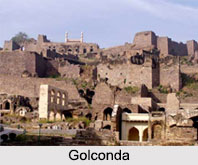 Located in southern India, deep within the old city of Hyderabad lays the ancient ruined historical city and fort of Golconda. The city is 8 km west of Hyderabad in the state of western Telangana and lies between the lower reaches of the Godavari and Krishna rivers, extended to the coast of Bay of Bengal.
Located in southern India, deep within the old city of Hyderabad lays the ancient ruined historical city and fort of Golconda. The city is 8 km west of Hyderabad in the state of western Telangana and lies between the lower reaches of the Godavari and Krishna rivers, extended to the coast of Bay of Bengal.
History of Golconda
Originally known as Mankal, Golconda slowly rose to prominence under the Bahmani Sultanate. When the Bahmani rule gradually weakened, Sultan Quli Qutb-ul-Mulk made Golconda the seat of his government and later turned it into the capital city of the Qutb Shahi dynasty. In 1687 the ruling dynasty of Qutb Shahi was overthrown by the Mughal emperor Aurangzeb, and Golconda was annexed by the Mughal Empire (1526-1857).
Golconda was one of the five major diamond mine groups in ancient India. The mines include the Kollur mines, the Paritala mines and the Muleli or Malavilly mines, of which Kollur was the richest. The famous diamonds excavated from the mines of Golconda are Daria-i-Noor or the Sea of light, the Hope Diamond, the Noor-ul-Ain, the Koh-i-Noor and the Regent Diamond. During the Renaissance and the early modern eras, Golconda became synonymous for vast wealth.
Architecture of Golconda
The city of Golconda was built on a granite hill with a height of 120 metres, surrounded by massive battlements. The fort of Golconda was expanded by the first three Qutb Shahi kings into a massive structure of granite extending around 5 km in circumference with a 7 km outer wall that enclosed the city. The state became a focal point for Shia Islam in India. Golconda actually consists of four distinct forts and semicircular bastions (some still mounted with cannons), eight gateways, and four drawbridges, with a number of royal apartments and halls, temples, mosques, stables, etc. The lowest of these is the outermost enclosure into which one can enter by the Fateh Darwaza also known as the victory gate. It was named when Aurangzeb"s triumphant army marched through the gate. The gate was studded with giant iron spikes near the south-eastern corner, to prevent elephants from battering them down.
Tourism in Golconda
The city of Golconda is an ideal tourist destination with many historical monuments. The most important one is the Golconda Fort, which lies on a hill. However, most of the splendid monuments built by the Qutb Shahi kings are in ruins. The Fort has a perfect acoustical system by which a handclap made at the main gates of the fort and the grand portico was heard from the top of the citadel. This citadel was situated on a 300-foot high granite hill and this is one of the major attractions in the fort. The other attraction in the city is the tombs of the Qutb Shahi sultans, which have intricately carved stonework and encircled by gardens.
Golconda is a major tourist attraction located 11 km west from the city of Hyderabad. It is one of the famous sight-seeing places in the city.



















